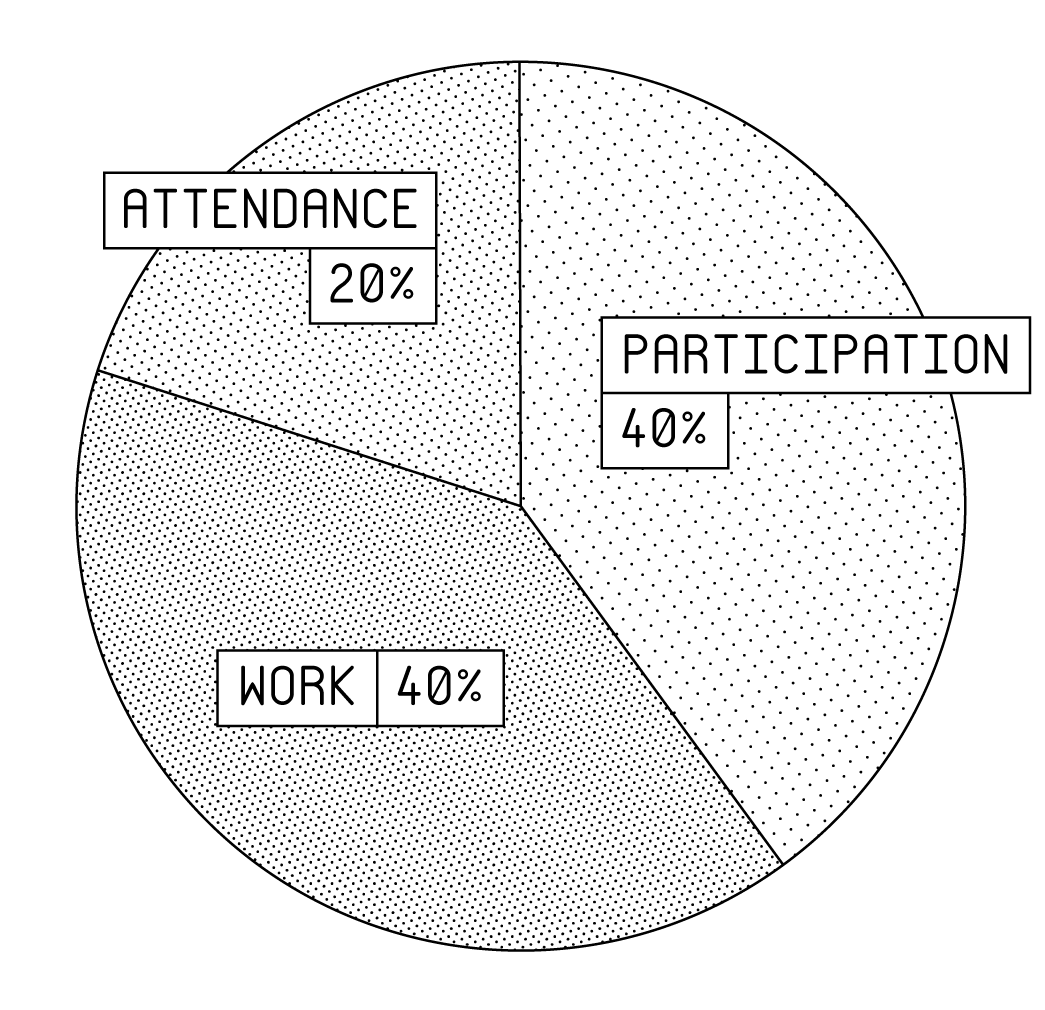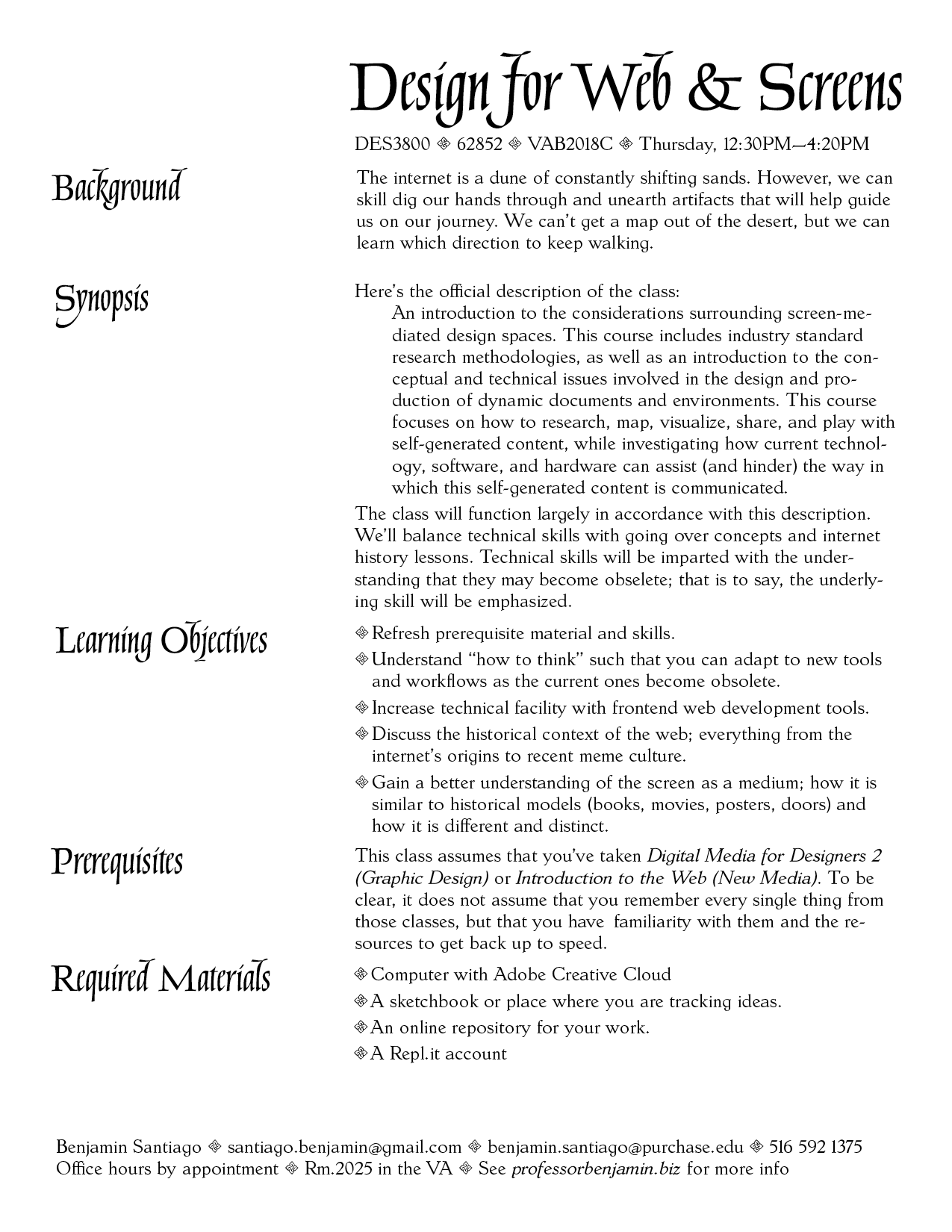SUNY Purchase︎(DES3800) Design for Web & Screens
Introductions & Expectations
(there’s a lot of stuff here, but it’s mostly for reference & clarity)Background
The internet is a dune of constantly shifting sands. However, we can skill dig our hands through and unearth artifacts that will help guide us on our journey. We can’t get a map out of the desert, but we can learn which direction to keep walking.Synopsis
Here’s the official description of the class:An introduction to the considerations surrounding screen-mediated design spaces. This course includes industry standard research methodologies, as well as an introduction to the conceptual and technical issues involved in the design and production of dynamic documents and environments. This course focuses on how to research, map, visualize, share, and play with self-generated content, while investigating how current technology, software, and hardware can assist (and hinder) the way in which this self-generated content is communicated.The class will function largely in accordance with this description. We’ll balance technical skills with going over concepts and internet history lessons. Technical skills will be imparted with the understanding that they may become obselete; that is to say, the underlying skill will be emphasized.
Learning Objectives
- Refresh prerequisite material and skills.
- Understand “how to think” such that you can adapt to new tools and workflows as the current ones become obsolete (they will).
- Increase technical facility with tools & languages for frontend web development (HTML/CSS/JavaScript/libraries/prototyping tools,etc.).
- Discuss the historical context of the web; everything from the internet’s origins to recent meme culture.
- Gain a better understanding of the screen as a medium; how it is similar to historical models (books, movies, posters, doors) and how it is different and distinct.
Prerequisites
This class assumes that you’ve taken Digital Media for Designers 2 (Graphic Design) or Introduction to the Web (New Media). To be clear, it does not assume that you remember every single thing from those classes, but that you have familiarity with them and the resources to get back up to speed.Attendance
As you know, SUNY Purchase, specifically the School of Art+Design, has a rather oppressive attendance policy (emphasis is my own):There are no excused absences in the School of Art+Design. Three or more absences in any course will result in a failing grade. Excessive tardiness may count as absences. Please see your course syllabi for more details.
- Be on time for class, within 10 minutes of the class’s start time, or...ya late.
- Being on time, ideally, means arriving a little bit before such that you’re ready to go at the class start time. This is most important for critique if we need to hang up work, or send files.
- I will send an advanced warning to everyone if I’m in danger of being late.
- Leaving class early without a valid reason (valid meaning, letting me know before class that you have to leave early) counts as being late.
- If you leave without explanation more than an hour before the class is done this will count as an absence.
- Three latenesses = 1 absence.
- It sucks to have to repeat the same thing again, so if you’re late, I will not go back and re-teach any demos or concepts until after a demonstration or discussion is done. Please don’t disturb another student who was on time unless they are ahead and able to help you.
- If you have a medical condition, job, or something going on personally that prevents you from getting to class on time, completing work, or being in class the entire duration please discuss it for me so I know.
TL;DR be on time and just be in contact with me in advance if you are going to be late or cannot attend class.
Grading (the class)

I find most descriptions of the grading process a bit vague. Here’s an attempt to explain each grade letter by what through what two hypothetical people did in a semester; in as few words as possible.
A
I have to tell you to stop participating in class discussions & your work consistently goes beyond the boundaries of the assignment (in a good way).
You are somewhat timid in class but your work possesses a certain je ne sais quoi, or your work is more advanced and you are forced into this class by some twist of fate.
B
Your work is well constructed and shows a noticable amount of effort and dedication, is submitted on time and you participate frequently in class. You were late to six classes without discussing with me at any point in the semester that you have a job, and your shift ends right before class.
Your work almost always shows an excellent level of effort and exploration, however you struggled significantly with between one and two projects.
C
You’ve shown up to class on time for every class, you’ve done the minimum requirements for every assignment, and you rarely participate in class discussions and critiques.
You communicate and participate in class discussion, but not to the degree where I’d have to tell you to stop to let other people join in. You submitted several of your assignments late but they showed promise and effort.
D & F
(If you are in danger of getting a D or an F,you will more than likely be notified in advance)
You did (almost) nothing during the semester, the work you did hand in was multiple weeks late, you have to be reminded (constantly) to get off your telephone.
Your work was extremely shoddily constructed and seems like you made it a couple minutes before class and you were absent for three weeks without letting me know.
Grading (assignments)
Assignments will be graded on the following criteria:
-
Appropriateness (20%) ︎Is the outcome related to the prompt? Did you follow whatever directions were involved and meet the minimum requirements?
- Craft/Execution
(20%)
︎ This encompasses both digital and “analog” craft. If you needed to trim something, is it trimmed cleanly? Is your print out all wrinkled and shit? If I examine your files, are the layers well organized?
- Effort
(20%)
︎ How many versions did you try? Did you simply go with your first idea? Did you attempt something outside of your comfort zone (which might take more time)?
- Exploration (20%) ︎ Did you attempt one or more of the challenges in the project sheet? Did you learn a new piece of software or technique not outlined in the project? Did you do extensive (documented) research about a topic related to your piece?
- Development
(20%)
︎ Does the project reflect an evolution in your personal development as a designer?
- je ne se quoi (+10%) ︎ Je ne se quoi is French for “I know not what.” Grading + subjectivity is hard, to that end, I’m adding an additional 10% to account for that. I will not grade you above 100% for an assignment but I will “bank” this factor for extra credit. This also includes the “no shuriken mode” challenges which will be part of all assignments.
All assignments are due on the date outlined in the physical project sheet & project web page. The following conditions constitute a late assignment:
- You don’t have your project with you in any form.
- Your project requires printing, and you did not print it out.
- Your project requires a dongle or specific software and you didn’t check if the classroom had it at least 24 hours before class.
- Your project required it be sent in some form (ie via email), in advance and you did not send it.
- You had an extenuating circumstance preventing you from completing the assignment, however you did not communicate with me at least 24 hours prior to class or figure out an alternative method of delivery.
Late work is subject to the following conditions:
- Your work will not be critiqued.
- You may submit your assignment again any subsequent week, however you will lose an entire letter grade for your assignment each week.
| The point here is that due dates are (almost always) attached to a critique. Critique is super important to me, and valuable to your development as a designer (and human). A critique where everyone has their work, everyone talks about each other’s work, and everyone has put a suitable amount of effort into their work to help generate conversation is a good critique. Additionally, as we will get more into, being a graphic designer is not simply about being a designer of graphics. I totally understand the reality of doing things at the last minute, however handing things in on time, planning, and communicating with clients and colleagues effectively is part of your job. Often times being fun and easy to work with can make up for a lack of raw “talent.” |
A note here, specific to this class, that I understand that learning a new skill, it can be difficult to have ideas or you may be super interested in the technical components at the expense of your concepts for your work. I will factor this in when grading.
Required Materials
-
Computer with Adobe Creative Cloud
(namely anything you use for image making Photoshop, Adobe Illustrator, and Adobe XD for prototyping) - A sketchbook or place where you are tracking ideas.
- An online repository for your work.
- A Repl.it account︎ (Coding can be hard, it’s even harder to convey concepts to 15+ people simultaneously at varying skill levels and physical proximities to me. Repl.it is a platform for teaching coding, it’s not unlike Google Docs but for code. It will make things slightly easier, and allow us to collaborate on code. Create a free account and let’s get it poppin’! Put your link in this spreadsheet︎)
